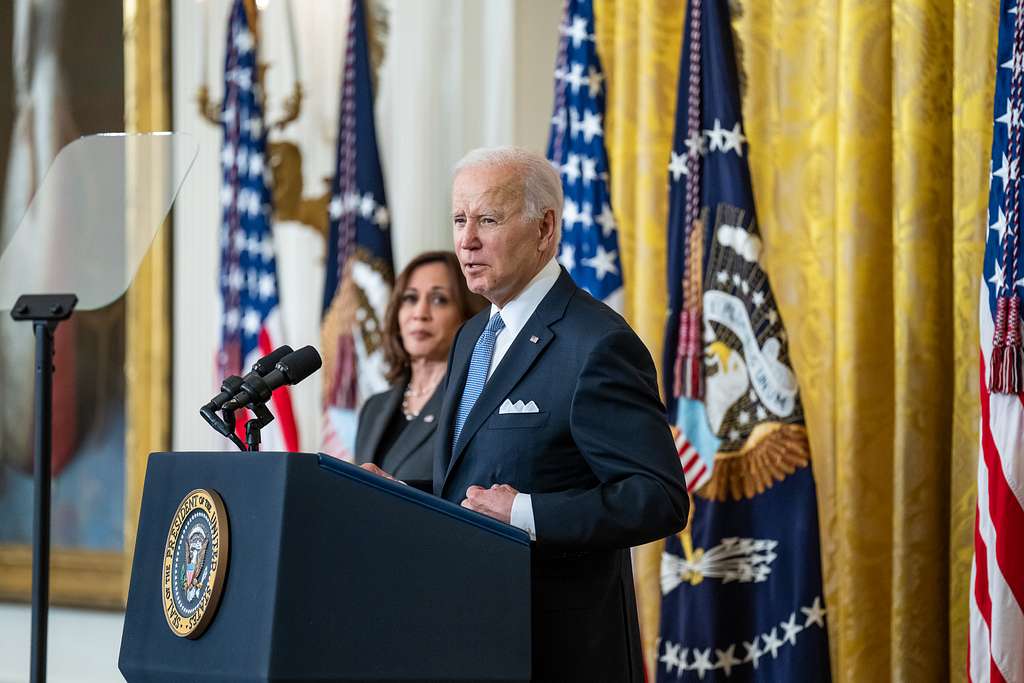What's In the FY 2025 Budget for Broadband and Technology
The fiscal year 2025 budget has funds for broadband expansion, tech innovation and digital equity.
Jericho Casper

WASHINGTON, March 20, 2024 – The White House unveiled its proposed fiscal year 2025 budget last week, earmarking $6 billion for enhancing internet affordability for consumers and $112 million for expanding rural broadband infrastructure.
The proposed budget underscores that certain broadband and technology initiatives are integral to President Joe Biden's economic vision of reducing costs, stimulating job growth, boosting manufacturing, and ensuring the protection of American consumers.

Additionally, the budget allocates over $20 billion to bolster semiconductor manufacturing leadership and establish tech innovation hubs in underserved regions.
Moreover, it prioritizes attracting top-tier technology talent to federal agencies and implementing the administration’s October 2023 executive order on the safe and secure development of artificial intelligence.
However, the realization of these ambitious plans hinges on navigating the legislative process in Congress, with approval timelines subject to negotiation and potential delays. As the fiscal year typically begins on October 1st, Congress aims to pass budget resolutions and appropriations bills well in advance to ensure seamless government operations.
FCC’s Affordable Connectivity Program - $6 billion
A significant portion of broadband funding in the FY25 Budget is designated for the Affordable Connectivity Program, with the budget incorporating the administration's pending supplemental request of $6 billion to sustain the program through 2024.
Furthermore, the administration expresses its explicit commitment to collaborating with Congress to secure additional funding for the ACP initiative in 2025 and beyond.
According to the proposed budget, the ACP has assisted 23 million households in saving over $500 million per month on internet expenses.
The program was set up with a $14 billion allotment from the 2021 Infrastructure Investment and Jobs Act. Funding for the program is set to last until April, marking the final fully supported month.
The program provides monthly $30 discounts on internet service for low-income households and up to $75 monthly discounts for eligible households on tribal lands and in high-cost areas. Additionally, it offers a one-time discount of up to $100 off the price of an electronic device.
USDA’s ReConnect program - $112 million
The 2025 budget proposes allocating $112 million to the U.S. Department of Agriculture’s ReConnect program.
USDA's Rural eConnectivity Loan and Grant ‘ReConnect’ Program provides funding to organizations to deploy broadband infrastructure in underserved areas, with a particular focus on tribal regions.
Recipients of ReConnect funding are required to ensure that their broadband networks achieve symmetrical speeds of at least 100 Megabits per second.
Through the 2021 Infrastructure Investment and Jobs Act, the USDA was provided $2.3 billion to expand broadband access to rural areas across 35 states and territories. These efforts are expected to connect more than 137,000 households, according to the proposed budget.
CHIPS and Science Act - $20 billion
The bulk of the funding allocated through the 2025 proposed budget for tech initiatives is directed toward substantial investments in America’s semiconductor industry, in accordance with the provisions outlined in the CHIPS and Science Act of 2022.
The investment of $20 billion would be spread across major research agencies to spur American leadership in semiconductor research, development and production.

At the National Science Foundation, these investments would cover a range of areas, including backing regional innovation initiatives, funding emerging technologies like AI and quantum information science, including quantum computing, and launching initiatives aimed at fostering workforce development in science, technology, engineering, and mathematics.
Under the agenda, the 2025 budget aims to safeguard supply chains and national security interests, strengthen American leadership in manufacturing, and enhance the availability of accurate economic data about the nation.
The proposed allocation for FY25 represents a $1.2 billion increase from the appropriation of FY23.
EDA’s tech hubs program - over $4 billion
The FY25 budget allocates $4 billion in mandatory funds for the U.S. Economic Development Administration’s Regional Technology and Innovation Hubs Program, enacted as part of the CHIPS and Science Act of 2022.
The Tech Hubs Program program provides funding and support to establish hubs that serve as centers for innovation, collaboration, and economic growth.
These hubs are designed to bring together businesses, research institutions, entrepreneurs, and other stakeholders to promote the development and commercialization of new technologies, spur job creation, and enhance the competitiveness of regional economies.
Additionally, $41 million in discretionary funding is earmarked for smaller grants aimed at nurturing technological and innovative progress in underrepresented regions.
In aggregate, this funding empowers the EDA to establish dynamic and targeted regional technology hubs, promoting geographic diversity in innovation and generating high-quality employment opportunities within underserved and vulnerable communities nationwide.
Tech hubs supported by the EDA concentrate on advancing various technologies spanning multiple industries, including: information technology, software development, agricultural and food technologies, artificial intelligence and machine learning, Internet of Things ‘IoT’ devices and other connectivity solutions.
In line with the CHIPS and Science Act, the Department of Commerce has unveiled 31 tech hubs aimed at transforming communities nationwide into hubs of innovation crucial for American competitiveness, as outlined in the FY25 Budget.
Executive order on Artificial Intelligence - $65 million
The budget also proposes $65 million to the Commerce Department to oversee, regulate, and advance artificial intelligence, with a focus on safeguarding the American public from its societal risks.
This funding will enable the Commerce Department to effectively execute key aspects of the administration's Executive Order 14110, titled "Safe, Secure, and Trustworthy Development and Use of Artificial Intelligence."
Specifically, the National Institute of Standards and Technology would establish the U.S. AI Safety Institute to operationalize NIST’s AI Risk Management Framework.
This will involve developing guidelines, tools, benchmarks, and best practices for assessing and mitigating potentially harmful capabilities of AI. Activities will include evaluations such as red-teaming exercises to identify and address AI-related risks.
The institute's responsibilities will extend to providing technical guidance for regulators considering rulemaking and enforcement actions on various AI-related issues.
These include authenticating human-created content, watermarking AI-generated content, combating algorithmic discrimination, ensuring transparency, and facilitating the adoption of privacy-preserving AI.
Additionally, the institute will play a pivotal role in shaping the future workforce trained in the safe and reliable use of AI technologies.
Additional funding directed towards AI initiatives is designated for agencies to appoint "chief AI officers" responsible for overseeing their agency's utilization of AI technology.
These officers will work towards implementing new AI technologies to enhance government services while also establishing essential safeguards to protect the rights and safety of the public in AI applications.
U.S. Digital Services Team - no exact budget allocation specified
The budget proposal sustains investment in the U.S. Digital Service, which recruits top-tier technology talent from the private sector to tackle complex challenges within federal agencies.
Deployed across various departments, USDS personnel augment existing teams with fresh skills and expertise. Over the past decade, USDS has played a pivotal role in modernizing agency operations, by mitigating risks associated with large IT projects historically prone to failure.
For instance, USDS is aiding the Federal Communications Commission in expanding broadband access, assisting the Internal Revenue Service in upgrading outdated systems for better taxpayer services, and helping the Department of Health and Human Services streamline Medicaid enrollment processes.
The budget also includes an additional $32 million for the USDS, General Services Administration, and the Office of Personnel Management to support the National AI Talent Surge initiative across the federal government.
GSA’s Technology Modernization Fund - $75 million
The FY25 Budget allocates an additional $75 million to the Technology Modernization Fund, a reserve of unrestricted funds utilized for enhancing cybersecurity and modernizing outdated IT infrastructure across various federal departments and agencies, managed by the General Services Administration.
While the American Rescue Plan Act previously boosted the fund by over $1 billion, according to GSA's budget justification, TMF "is on track to allocate the vast majority of current funds…and is planning to announce several large value investments in the first half of 2024."
Bolstering antitrust enforcement - $288 million
The budget proposes $288 million for the antitrust division of the Department of Justice.
This $288 million includes $13.7 million and 83 positions for enhanced antitrust enforcement, $14.9 million for technology and data modernization support, and $23.9 million for sustaining IT operations.
The aim is to bolster antitrust enforcement efforts, fostering robust competition in the marketplace and ultimately reducing costs while raising wages for the American people.
This marks a $63 million increase from the 2023 enacted level and a $103 million increase from the 2021 enacted level.
Addressing emerging cyber threats - $32 million
The budget amplifies the Department of Justice's capacity to combat cyber threats by bolstering the FBI's cyber and counterintelligence investigative capabilities.
This includes a $25 million increase to fortify cyber response capabilities, sustaining the FBI's cyber intelligence, counterintelligence, and analytical prowess.
Additionally, $5 million is allocated to expand a new division within the DOJ's National Security Division dedicated to addressing cyber threats.
Furthermore, the budget allocates $2 million for DOJ to support the implementation of Executive Order 14110, "Safe, Secure, and Trustworthy Development and Use of Artificial Intelligence."












Member discussion